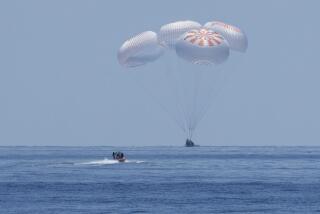San Diego to Be Home for Kitty Hawk Again
SAN DIEGO — The aircraft carrier Kitty Hawk, which left its San Diego home port destined for a new base in Florida, will return here next year, bringing with it a $100-million surge to the local economy, officials in Washington said Wednesday.
In a military-style shell game reflecting political muscle as well as financial penny-pinching, the first carrier ever assigned to San Diego--the “Hawk”--once again will be based here. Navy officials first assigned the Hawk to Pensacola, Fla. Instead, several carriers have been juggled and the Hawk is coming home.
For the record:
12:00 a.m. Aug. 31, 1990 For the Record
Los Angeles Times Friday August 31, 1990 San Diego County Edition Metro Part B Page 2 Column 1 Metro Desk 2 inches; 42 words Type of Material: Correction
Shelter Island--The Times incorrectly reported that Shelter Island was created in 1961 as a result of dredging in San Diego Bay. Shelter Island was actually created during the early 1950s. Harbor Island was formed in 1961 when the Navy dredged the bay to accommodate large ships like aircraft carriers.
“It’s going to mean a tremendous economic boost,” said one Navy official, who requested anonymity. “This is a recognition of the city’s importance and its necessity as a strategic home port.”
Why San Diego?
Brushing aside the city’s strategic location and its berthing capacity, another highly placed Navy official said: “Of course, there was political pressure--that ship means a lot of money to a community.”
After rejiggering the initial game plan, the aircraft carrier Forrestal will now be based in Pensacola, where it will replace the Lexington, which is being retired as Pentagon officials opted to reduce the number of Navy carriers to cut costs. Navy officials in Washington planned to announce the new carrier scheme within days, sources said.
“San Diego is very nearly an ideal operational facility for carriers,” said Retired Rear Adm. Eugene Carroll Jr., who served as the Kitty Hawk’s executive officer in 1965, when the ship was based here. “You have two air stations available, a major repair facility, an accessible harbor and, of course, the community attitude toward the Navy is superb.”
Word that the Kitty Hawk will return to San Diego comes only six months after Navy officials announced that the aircraft carrier Independence will be assigned to Japan in 1991. This decision meant that, for the first time in more than 20 years, San Diego would have only one carrier, the Ranger.
The city’s other carrier, the Constellation, departed last winter for a 29-month overhaul at the Philadelphia Naval Shipyard. The Constellation is scheduled to return here in 1993, once its $800-million refurbishment is completed.
The Kitty Hawk, which left San Diego in 1987, is returning from the same program, where it underwent a three-year face lift. The overhaul is expected to add 15 years to its service life.
In recent years San Diego has been home to three carriers. And eight local shipyards have divvied up about $25 million in repairs for each carrier annually. In addition, the carriers, which are host to about 5,000 sailors and airmen, mean a tremendous boost to the community because the crew’s families usually relocate to accompany each ship.
But for Carroll and others, the Kitty Hawk holds a special place because of how it helped shape the city, as well as the financial boon it provided. When the 80,000-ton Hawk arrived here in November, 1961, it was the city’s first aircraft carrier. To accommodate the gargantuan vessel with its 4-acre landing deck, city officials had to dredge the bay, creating a 42-foot-deep, 3-mile channel. The dredging also created a man-made spit, Shelter Island, which has since thrived with hotels and restaurants.
During the quarter of a century that the Kitty Hawk called San Diego home port, it served as a barometer of changing times. The Kitty Hawk, like other carriers, holds about 85 aircraft and serves as a mobile air base that can change its position by hundreds of miles in a day. And the hulking gray Hawk carried planes that flew more than 10,000 missions over Vietnam. It was also dispatched to the Indian Ocean during crises in Iran and Afghanistan.
But, in 1967, the Hawk gained notoriety when 11 crew members were arrested in Pearl Harbor for using marijuana in one of the Navy’s first efforts to battle drugs.
Then five years later, anti-war activist Joan Baez led a protest against the ship’s prominent role in the Vietnam War. The turmoil spread, and seven Kitty Hawk sailors sought refuge in local churches, but the AWOL sailors were arrested and returned to their ship.
The notoriety continued. Only months after the sailors tried to desert, the Hawk erupted again. This time it was a spasm of racial violence in which black and white sailors fought one another aboard the ship.
The Hawk apparently was never destined for a quiet life. In 1984, it again made headlines when it sideswiped a Soviet nuclear-powered submarine that had surfaced in its path in the Sea of Japan off South Korea.
A year later, the Hawk commanded the spotlight and again, it was not good news. In 1985, a Navy whistle blower alleged that Kitty Hawk brass allowed widespread fraud, theft and waste aboard the vessel. He claimed that crewmen tossed excess furniture and parts overboard instead of filling out the cumbersome required forms. The disappearance of more than a dozen bars of silver added to the intrigue.
More to Read
Sign up for Essential California
The most important California stories and recommendations in your inbox every morning.
You may occasionally receive promotional content from the Los Angeles Times.










